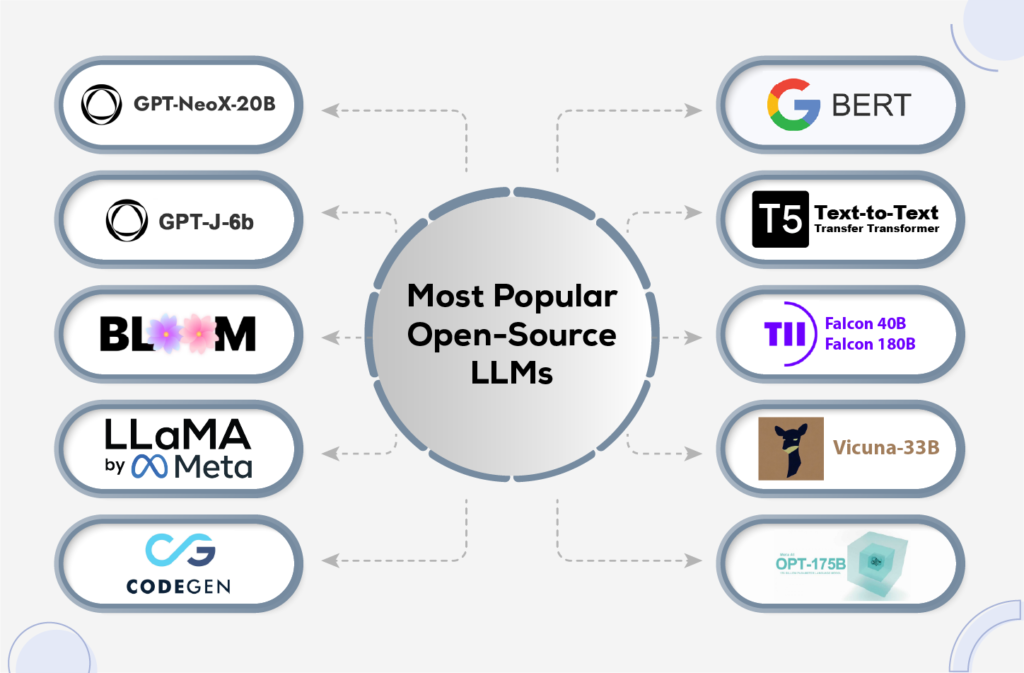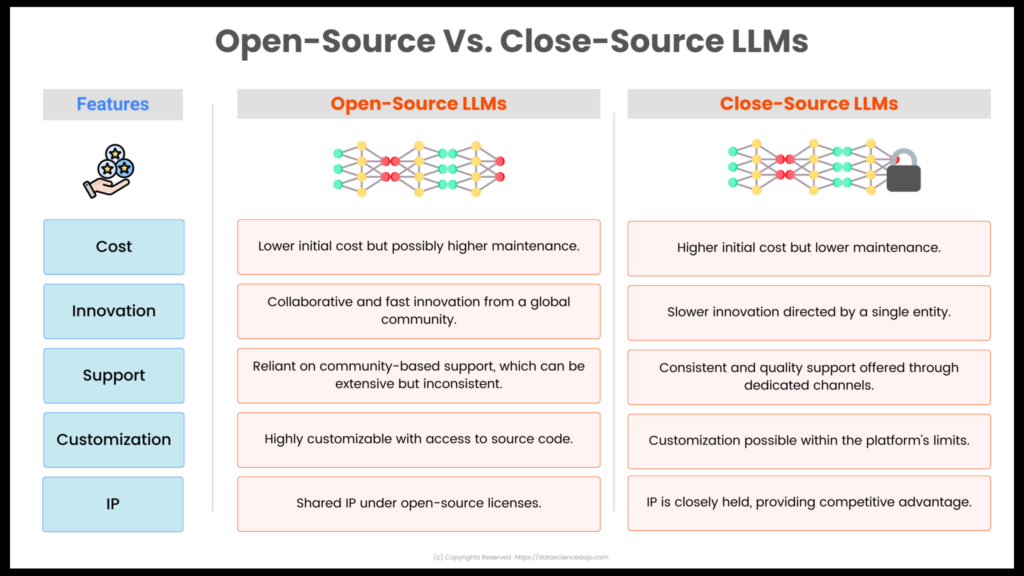In a world where data is growing at an exponential rate, the ability to extract relevant information has become a critical asset for tech companies. Today, large language models (LLMs) have become indispensable tools for analyzing vast datasets and automating a wide range of tasks.
However, with the rise of LLMs, a crucial question arises for companies: should they choose proprietary models or open-source models? Each option has its own advantages and drawbacks.
In this article, we will provide a detailed comparison of these two types of models in a business context. We’ll outline their strengths, limitations, and offer concrete examples to help companies make an informed choice based on their needs and goals.
Open-source models: freedom, transparency, and collaboration
Open-source language models stand out due to their freely accessible source code, allowing anyone to use, modify, or adapt them to their needs. This approach not only promotes freedom and customization but also fosters open collaboration among users worldwide.
This dynamic makes open-source models an attractive choice for companies looking for complete control over the technology they use.
Here are some detailed advantages :
- Control and flexibility : Open-source models allow full customization. For instance, a developer can fine-tune a model to meet specific needs, such as legal or medical assistance. This flexibility is especially useful for niche applications where a generic model may fall short.
- Community Support: These models benefit from the contributions of a vibrant community of developers and researchers, creating a collaborative environment that drives innovation. For example, Meta’s LLaMA model has an active community that shares solutions, updates, and tweaks, allowing small businesses to benefit from technological advancements without massive investments in R&D.
- Cost-Effectiveness : Another major advantage of open-source models is their lower cost, making them particularly attractive for startups and small businesses. For example, a company can use Mistral AI’s Mixtral model without paying licensing fees, significantly reducing upfront costs while still leveraging advanced technologies.
- Transparency : Transparency is essential, especially in regulated industries where the explainability of AI-driven decisions is critical. With an open-source model, developers have full access to the code and underlying data, enabling a better understanding of how the model works. In sectors like healthcare, where trust and security are paramount, this transparency ensures reliability and compliance.
Drawbacks of open-source models :
- Required Technical Expertise : One of the main challenges of open-source models is that they often require significant technical expertise. Customizing and deploying them demands advanced skills in development and machine learning. Without a skilled team, it can be challenging for a company to implement and optimize these models effectively, which may hinder companies lacking the necessary technical resources.
- Lack of Commercial Support : Unlike proprietary models, which benefit from professional technical support provided by vendors, open-source models rely primarily on community support. In case of technical issues or major outages, companies may find themselves without immediate assistance and must turn to documentation or community forums to find solutions.

Proprietary models: simplicity, support, and reliability
Proprietary models—or private models—are generally developed and controlled by large tech companies like OpenAI, Google, or Microsoft.
Unlike open-source models, private LLMs are designed to provide a simplified user experience, freeing companies from technical code management or underlying infrastructure concerns. This type of model is particularly popular among organizations looking to quickly deploy advanced AI technologies without significant investment in customization or in-house development.
Proprietary models are often pre-trained and ready for integration into enterprise systems, allowing companies to quickly benefit from AI’s advantages with reduced implementation time.
Here are some detailed advantages :
- Advanced Features and Optimized Performance : Proprietary models are often the result of several years of intensive research and development. They are continually optimized to offer maximum reliability and enhanced performance through regular updates, ensuring companies enjoy stability while minimizing risks of unexpected errors or malfunctions.
- Dedicated Support and Commercial Assistance : Technical support is a central aspect of proprietary models. Companies benefit from dedicated support services, which can be essential for addressing questions or quickly resolving critical issues. In sectors where service interruptions or processing errors can have costly or serious consequences, this level of support is a valuable security factor.
- Ease of Deployment and Use : One of the main advantages of proprietary LLMs is their practicality. These models are designed for easy integration into existing enterprise infrastructures with ready-to-use features. Providers of these models, such as OpenAI with GPT or Microsoft Azure with its cognitive services, offer clear documentation and detailed implementation guides, enabling companies to deploy solutions quickly, even without deep expertise in AI or model development.
These characteristics make proprietary LLMs an attractive option for companies looking for a turnkey solution, where reliability and support are essential to ensuring optimal performance.
Drawbacks of proprietary models:
- High Cost : Accessing these models, whether through licensing or cloud services, often represents a significant investment, especially for small businesses or startups. This cost includes not only access to the model itself but also fees associated with technical support, updates, and continuous use. For companies with limited budgets, this can represent a substantial entry barrier.
- Lack of Transparency : Proprietary models are often described as “black boxes.” The source code is not accessible, limiting companies’ ability to understand or audit how the model functions.
- Limited Flexibility : Choosing a proprietary model provides ready-to-use solutions, but at the cost of limited customization. For instance, a company looking to fine-tune a model to meet specific requirements may encounter technical restrictions imposed by the provider. This rigidity can hinder organizations that need a tailored AI solution to differentiate themselves or meet specific needs in their sector.
- Vendor Dependence : Companies adopting proprietary models are dependent on vendors for updates and support. For example, a company using GPT is subject to OpenAI’s decisions on future model developments, which can limit its ability to evolve or adapt the solution according to its specific needs.

Choosing the right model: a matter of needs and priorities
The best choice between an open-source and closed-source LLM depends on your vision and requirements. Ultimately, the decision is based on a careful assessment of the project’s needs, budget, and long-term goals. Consider factors such as:
- The level of control and customization desired
- Available technical expertise
- Budget constraints
- Need for dedicated support
- Importance of transparency and explainability
By weighing these factors carefully, you can make an informed decision and select the LLM that best matches your company’s needs, enabling you to lead your project toward success!




